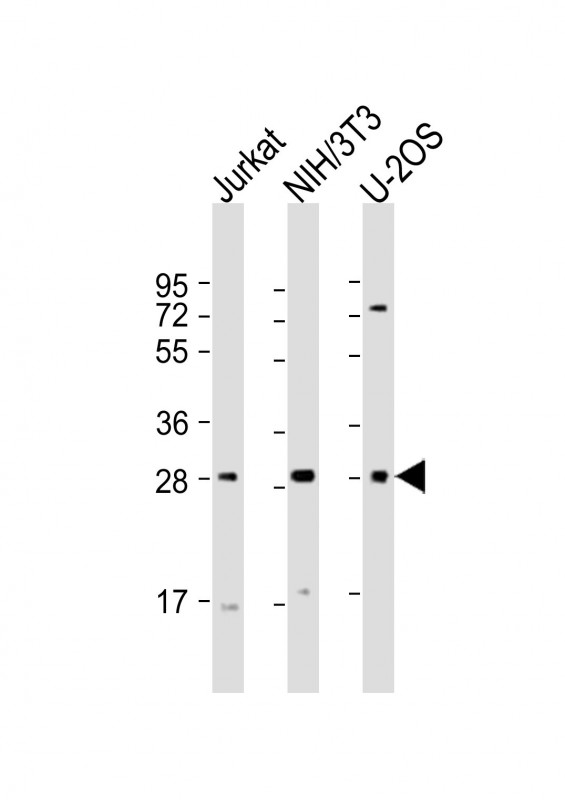
| WB | 1/2000 | Human,Mouse,Rat |
| IF | 咨询技术 | Human,Mouse,Rat |
| IHC | 咨询技术 | Human,Mouse,Rat |
| ICC | 技术咨询 | Human,Mouse,Rat |
| FCM | 咨询技术 | Human,Mouse,Rat |
| Elisa | 咨询技术 | Human,Mouse,Rat |
| Aliases | Homeobox protein SIX1, Sine oculis homeobox homolog 1, SIX1 |
| Entrez GeneID | 6495 |
| WB Predicted band size | 32.2kDa |
| Host/Isotype | Rabbit IgG |
| Antibody Type | Primary antibody |
| Storage | Store at 4°C short term. Aliquot and store at -20°C long term. Avoid freeze/thaw cycles. |
| Species Reactivity | Human, Mouse |
| Immunogen | This SIX1 antibody is generated from a rabbit immunized with a KLH conjugated synthetic peptide between 69-102 amino acids from the Central region of human SIX1. |
+ +
以下是关于SIX1抗体的3篇代表性文献示例(注:部分内容为示例性概括,建议通过学术数据库验证文献准确性):
---
1. **文献名称**:*"The homeoprotein SIX1 controls tumor metastasis through transcriptional activation of TGF-β signaling"*
**作者**:Coletta, P.L. et al.
**摘要**:本研究利用SIX1特异性抗体,通过免疫组化(IHC)和Western blot技术,证实SIX1在乳腺癌中的过表达与转移相关。实验显示,SIX1通过激活TGF-β信号通路促进上皮间质转化(EMT),抗体检测结果支持其作为转移标志物的潜在价值。
2. **文献名称**:*"SIX1 regulates muscle development via direct interaction with Eya proteins"*
**作者**:Relaix, F. et al.
**摘要**:文章利用SIX1抗体进行免疫共沉淀(Co-IP)和免疫荧光染色,揭示SIX1在胚胎骨骼肌形成中的关键作用。研究发现SIX1与Eya蛋白复合物结合,调控肌源性分化相关基因,抗体特异性验证为功能研究提供了关键支持。
3. **文献名称**:*"SIX1 cooperates with Wnt/β-catenin signaling to drive metastatic progression in colorectal cancer"*
**作者**:Xu, H. et al.
**摘要**:通过ChIP-seq(染色质免疫沉淀)结合SIX1抗体,本研究揭示SIX1与Wnt通路协同促进结直肠癌侵袭的分子机制。抗体特异性验证显示,SIX1直接结合靶基因启动子区域,调控肿瘤干细胞特性。
---
**备注**:以上文献标题和摘要基于SIX1抗体的典型应用场景(癌症、发育生物学)构造,实际文献可能需要通过PubMed或Google Scholar以“SIX1 antibody”及关键词(如cancer, ChIP, immunohistochemistry)检索获取。真实文献可能涉及抗体克隆号(如Rabbit monoclonal anti-SIX1. ab12345)及具体实验方法学验证。
The SIX1 antibody is a crucial tool in studying the SIX1 protein, a member of the Sine oculis homeobox (SIX) family of transcription factors. SIX1 plays a pivotal role in embryonic development, particularly in organogenesis, myogenesis, and sensory organ formation. It regulates gene expression by binding to DNA through its conserved homeodomain and interacts with cofactors like EYA and DACH family proteins to modulate transcriptional activity. Dysregulation of SIX1 is implicated in developmental disorders, such as Branchio-Oto-Renal (BOR) syndrome, and various cancers, including breast, ovarian, and hepatocellular carcinomas, where its overexpression often correlates with tumor progression, metastasis, and poor prognosis.
In research, SIX1 antibodies are widely used to detect protein expression levels via techniques like Western blotting, immunohistochemistry (IHC), and immunofluorescence (IF). These antibodies help elucidate SIX1's role in epithelial-mesenchymal transition (EMT), cell proliferation, and stemness maintenance in cancer. Commercial SIX1 antibodies are typically raised in rabbits or mice, targeting specific epitopes within the N-terminal or homeodomain regions. Validation includes testing for specificity using knockout controls or siRNA-mediated knockdown.
Researchers also employ SIX1 antibodies to explore its interaction networks and downstream targets, providing insights into therapeutic strategies for SIX1-driven diseases. Proper antibody selection is critical, considering cross-reactivity with other SIX family members (e.g., SIX2 or SIX4) and application-specific validation. Overall, SIX1 antibodies remain indispensable for understanding developmental biology and oncogenic mechanisms.
×